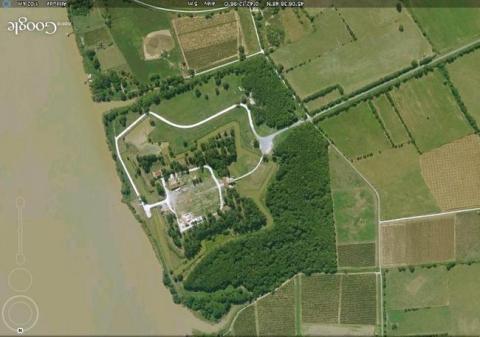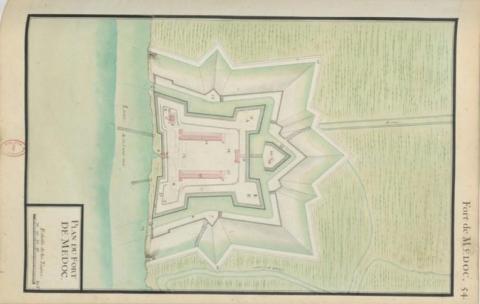Fort Médoc
History and description
Fort Médoc is situated on the left bank of the Gironde. It was constructed as a complement to the citadel of Blaye to block access to Bordeaux. Fort Pâté, situated in the middle of the estuary, forms the triptych. Its construction commenced in 1690 and finished two years later. It appears in the form of a square fort with four bastions linked by curtain walls and including a ravelin on its main gate, on the land-facing side. Entry is via a huge curvilinear pediment gate, the porte Royale, decorated with two telamons linked to the arms of Louis XIV created by the engineer Pierre Berquin and the architect Pierre-Michel Duplessy. This gate includes a guardroom and caseamtes, quarters for the commander, two barracks, a powder keg, a chapel and a fresh water cistern (the latter of which, a 19th century construction). The water in the moat comes via a system of locks which keeps the water flowing, regardless of the state of the marshes. The ramparts are made of earth, palisaded and laid on wooden sills in view of the marshy land.Current state
While the fort Médoc remains intact, the barracks have been demolished. A study for the purpose of promotion is currently underway. The fort Médoc is open to the public every day and guided visits are possible year-round by appointment. The triptych comprising the citadel of Blaye, the fort Pâté and the fort Médoc is included on the World Heritage List as part of the fortifications of Vauban.
Fort Médoc
Fort Médoc
45° 6' 40.5248" N, -0° 42' 8.6684" E
Type
fort
Engineers
Sébastien le Prestre de Vauban, Jean-Baptiste Augier, Pierre Berquin
Department
Gironde
Region
Nouvelle-Aquitaine
Bibliography
- COLAS (P.), Blaye, citadelle, boulevard du château, étude préalable, Bordeaux, 1991.
- COUTURA (J.), « Vauban à Blaye » in Les cahiers du Vitrezais, Paris, 1983, n°43.
- COUTURA (J.), « Quelques notes pour servir à l’histoire de la citadelle de Blaye, de Fort Pâté et Fort Médoc » in Les cahiers du Vitrezais, Paris, 1983, n°46.
- COUTURA (J.), « La construction du fort Pâté au milieu de la Gironde (1689-1693) » in Revue archéologique de Bordeaux, Bordeaux, 1991, t. LXXXII.
- Dossier de presse, candidature au patrimoine mondial de l’humanité, Cussac-Fort-Médoc, 2005.
- FAUCHERRE (N.), « La citadelle de Blaye » in Congrès archéologique de France, Paris, 1990, 145e session.
- MONGIN (M.), STEENBERGEN (M.), Le Verrou de l’Estuaire, Citadelle de Blaye, fort Pâté et fort Médoc, Woippy, 2014.

